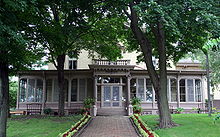Hercules L. Dousman

Hercules Louis Dousman (August 4, 1800 – September 12, 1868) was a trader and real-estate speculator who played a large role in the economic development of Wisconsin. He is often called Wisconsin's first millionaire.
Early life and trading activities
Dousman was born on Mackinac Island, Michigan, the son of Michael Dousman, a prominent fur trader on the island. Hercules went on to be educated in Elizabethtown, New Jersey, and then worked as a clerk in a New York City store. Later he returned to Mackinac Island, where he was employed by the American Fur Company. In 1826, the company sent Dousman to the frontier settlement of Prairie du Chien, Wisconsin, where he worked as an assistant to the company's local agent Joseph Rolette.
In Prairie du Chien, Dousman proved his abilities as a trader, quickly rising in the company's ranks. By 1834 he had acquired an interest in the company's Western Outfit, and in 1840 he became an equal partner in the business together with Joseph Rolette and Henry Hastings Sibley. Then in 1842 the American Fur Company declared bankruptcy, and in order to continue in the trade Dousman entered into a joint venture with Rolette, Sibley, and Pierre Chouteau to organize a new company which would take its place on the upper Mississippi. Only a few months later, Rolette died in debt to the new company, and most of his estate was seized by the remaining partners, including Dousman. With this and other revenue, Dousman's wealth began to rise, and it only grew as Dousman began to invest in lumber mills in northern Wisconsin and real estate in some of the states growing population centers.
As Dousman began building his investments during the 1830s, he also began a long affair with a Prairie du Chien woman named Margaret Campbell. Together they had three children: Emily, George, and a third unnamed child who died at birth in 1838. Campbell also died at that time. Dousman would eventually marry Jane Fisher Rolette, the soon-to-be widow of his partner in the trade, Joseph Rolette.
Community leader

In 1844, two years after Joseph Rolette's death, Dousman would marry his widow, Jane. Together the couple moved into the large two story brick house that Dousman had constructed a year earlier. Today this house, which was replaced by the Villa Louis in the 1870s, is called the "House on the Mound", because of its location atop what is believed to be a prehistoric Indian mound. Hercules and Jane Dousman had one son, Hercules Louis Dousman II, who was born on April 3, 1848. Less than two months after the child's birth, Wisconsin became a state.
As Wisconsin grew, the fur trade was sent into decline, primarily because the Native Americans who formed an essential part of the trade were being pushed west by new settlers. Dousman withdrew from the fur trade in the late 1840s in order to focus on his investments. In addition to his numerous holdings in real-estate, grain, and lumber, Dousman became involved in transportation companies, investing in packet companies and steamboats that ran on the Mississippi River.
In 1852, Dousman became a principal investor in the Madison & Prairie du Chien Railroad, a company formed to ensure that the larger Milwaukee & Mississippi Railroad would meet its goal of connecting Lake Michigan with the Mississippi River. The two companies combined only a few years later, and would eventually grow into the Chicago, Milwaukee, St. Paul and Pacific Railroad. Dousman was very influential in bringing the railroad to Prairie du Chien by 1857, making the Milwaukee & Mississippi the first railroad to lay track all the way across Wisconsin. Prairie du Chien's new rail connection caused a small boom in the city's population and business. Since Dousman owned much of the land in the city he made a large profit from this, and his net worth grew substantially, reaching a million dollars at a time when fewer than a thousand Americans could claim to possess such a figure.
Death
Dousman died of heart failure on September 12, 1868. By this time he was regarded as one of Wisconsin's wealthiest and most influential men, and his property passed to his wife Jane and son Louis. Dousman has since been immortalized by the Villa Louis historic site in Prairie du Chien and as the central character of two novels by August Derleth, Bright Journey and The House on the Mound. Dousman is buried at Calvary Cemetery in Prairie du Chien.[1]
